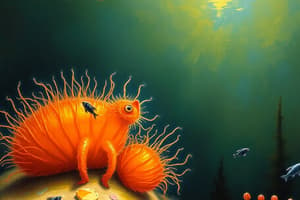Podcast
Questions and Answers
Jaką rolę odgrywają protisty jako 'producenty pierwotne'?
Jaką rolę odgrywają protisty jako 'producenty pierwotne'?
- Rozkładają materię organiczną
- Pełnią funkcje ruchu poprzez wici i flagella
- Żerują na bakteriach i innych organizmach jednokomórkowych
- Przekształcają energię świetlną w energię chemiczną poprzez fotosyntezę (correct)
W której z wyżej wymienionych królestw umieszczane są niektóre protisty, takie jak algi?
W której z wyżej wymienionych królestw umieszczane są niektóre protisty, takie jak algi?
- Królestwo Roślin (Plantae) (correct)
- Królestwo Zwierząt (Animalia)
- Królestwo Monerów (Bacteria)
- Królestwo Grzybów (Fungi)
Jakie organella mogą być obecne u protistów według tekstu?
Jakie organella mogą być obecne u protistów według tekstu?
- Płaty boczne i śródrzęstki
- Plastidy, mitochondria i wici (correct)
- Pory jądrowe i centriole
- Jądra komórkowe i aparaty Golgiego
Do którego z wymienionych domin może należeć protista?
Do którego z wymienionych domin może należeć protista?
Która z poniższych roli nie jest typowa dla protistów?
Która z poniższych roli nie jest typowa dla protistów?
Do której z wymienionych grup przynależą protisty, takie jak Excavata i Chromalveolata?
Do której z wymienionych grup przynależą protisty, takie jak Excavata i Chromalveolata?
Które z poniższych stwierdzeń najlepiej opisuje grupę protistów jaką są protozoi?
Które z poniższych stwierdzeń najlepiej opisuje grupę protistów jaką są protozoi?
Jakie jest główne źródło odżywiania dla glonów?
Jakie jest główne źródło odżywiania dla glonów?
Jakie cechy wyróżniają śluzówki spośród innych grup protistów?
Jakie cechy wyróżniają śluzówki spośród innych grup protistów?
Które z poniższych stwierdzeń jest prawdziwe dla cech protistów?
Które z poniższych stwierdzeń jest prawdziwe dla cech protistów?
Która z poniższych grup nie jest kategorią protistów?
Która z poniższych grup nie jest kategorią protistów?
Jakie role odgrywają protisty w ekosystemach?
Jakie role odgrywają protisty w ekosystemach?
Flashcards are hidden until you start studying
Study Notes
Protists: A Diverse and Vital Part of Life's Endless Variety
Protists, a group of eukaryotic organisms, are often misunderstood due to their diverse and sometimes unique characteristics. They occupy a fascinating niche in the vast kingdom of life, and understanding their types, characteristics, classification, and roles in ecosystems provides valuable insights into the intricacies of our natural world.
Types of Protists
Protists are a polyphyletic group, meaning they share some traits but lack a unifying evolutionary origin. They are commonly categorized into several groups:
- Protozoa: Single-celled organisms that are motile or non-motile and obtain nutrition through ingestion. They include amoebas, ciliates, and flagellates.
- Algae: Photosynthetic eukaryotes that are often multicellular. They are classified as phytoplankton, macroalgae, and microalgae, depending on their size and habitat.
- Slime molds: Multi-cellular organisms that are heterotrophic, meaning they feed on other organic matter. They are temporary, relying on a single-celled stage for reproduction.
Characteristics of Protists
Protists exhibit a wide range of characteristics that deviate from the typical plant or animal groupings. Some of the notable traits include:
- Heterotrophic and autotrophic nutrition: Protists can obtain their nutrients via two routes: heterotrophic (feeding on other organic matter) and autotrophic (photosynthesis).
- Cell membrane: Protists have a plasma membrane like plants and animals, but they lack cell walls.
- Organelle diversity: Protists exhibit a diverse array of organelles, including plastids, mitochondria, and flagella, which can be found in varying forms and configurations.
Classification of Protists
The classification of protists is continually evolving as scientists attempt to better understand their relationships with other eukaryotic organisms. While they are not part of the animal or plant kingdoms, some protists, like algae, are placed into the Plantae kingdom, and others, like protozoa, are part of the Animalia kingdom.
- Domains: Eukarya, Bacteria, and Archaea
- Kingdoms: Animalia, Plantae, Fungi, Monera (Bacteria), and Archaea
- Supergroups: Excavata, Rhizaria, Chromalveolata, Archaeplastida, and Amoebozoa
- Phyla: Various phyla within supergroups (e.g., Alveolata, Stramenopiles, and Cercozoa)
Roles of Protists in Ecosystems
Protists play pivotal roles in ecosystems, serving as primary producers, decomposers, and predators.
- Primary producers: Algae, particularly phytoplankton, are essential primary producers in aquatic ecosystems. They convert light energy into chemical energy through photosynthesis, forming the base of the food chain.
- Decomposers: Protists like ciliates and protozoa break down organic matter, playing a crucial role in nutrient cycling and maintaining ecosystem stability.
- Predators: Some protists, like ciliates and heterotrophic flagellates, feed on bacteria and other single-celled organisms, regulating microbial populations in aquatic ecosystems.
Understanding the roles of protists is essential for maintaining the stability and health of ecosystems. They are vital for nutrient cycling, energy transfer, and overall ecosystem balance.
In conclusion, protists are a fascinating group of organisms that exhibit a wide range of characteristics, classification, and roles in ecosystems. Their diversity and unique traits make them an invaluable part of the natural world, and further research will undoubtedly continue to reveal their full potential and significance.
Studying That Suits You
Use AI to generate personalized quizzes and flashcards to suit your learning preferences.




